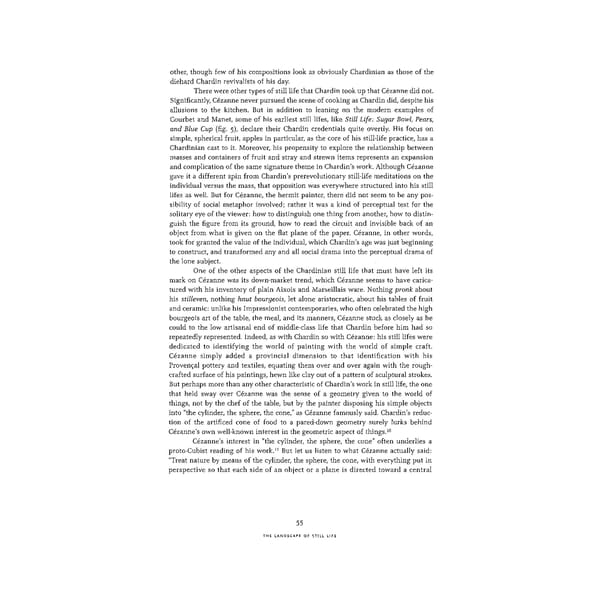other, though few of his compositions look as obviously Chardinian as those of the diehard Chardin revivalists of his day. There were other types of still life that Chardin took up that Cézanne did not. Significantly, Cézanne never pursued the scene of cooking as Chardin did, despite his allusions to the kitchen. But in addition to leaning on the modern examples of Courbet and Manet, some of his earliest still lifes, like Still Life: Sugar Bowl, Pears, and Blue Cup (fig. 5), declare their Chardin credentials quite overtly. His focus on simple, spherical fruit, apples in particular, as the core of his still-life practice, has a Chardinian cast to it. Moreover, his propensity to explore the relationship between masses and containers of fruit and stray and strewn items represents an expansion and complication of the same signature theme in Chardin's work. Although Cézanne gave it a different spin from Chardin's prerevolutionary still-life meditations on the individual versus the mass, that opposition was everywhere structured into his still lifes as well. But for Cézanne, the hermit painter, there did not seem to be any pos- sibility of social metaphor involved; rather it was a kind of perceptual test for the solitary eye of the viewer: how to distinguish one thing from another, how to distin- guish the figure from its ground, how to read the circuit and invisible back of an object from what is given on the flat plane of the paper. Cézanne, in other words, took for granted the value of the individual, which Chardin's age was just beginning to construct, and transformed any and all social drama into the perceptual drama of the lone subject. One of the other aspects of the Chardinian still life that must have left its mark on Cézanne was its down-market trend, which Cézanne seems to have carica- tured with his inventory of plain Aixois and Marseillais ware. Nothing pronk about his stilleven, nothing haut bourgeois, let alone aristocratic, about his tables of fruit and ceramic: unlike his Impressionist contemporaries, who often celebrated the high bourgeois art of the table, the meal, and its manners, Cézanne stuck as closely as he could to the low artisanal end of middle-class life that Chardin before him had so repeatedly represented. Indeed, as with Chardin so with Cézanne: his still lifes were dedicated to identifying the world of painting with the world of simple craft. Cézanne simply added a provincial dimension to that identification with his Provençal pottery and textiles, equating them over and over again with the rough- crafted surface of his paintings, hewn like clay out of a pattern of sculptural strokes. But perhaps more than any other characteristic of Chardin's work in still life, the one that held sway over Cézanne was the sense of a geometry given to the world of things, not by the chef of the table, but by the painter disposing his simple objects into "the cylinder, the sphere, the cone," as Cézanne famously said. Chardin's reduc- tion of the artificed cone of food to a pared-down geometry surely lurks behind 10 Cezanne's own well-known interest in the geometric aspect of things. Cezanne's interest in "the cylinder, the sphere, the cone" often underlies a 11 proto-Cubist reading of his work. But let us listen to what Cézanne actually said: "Treat nature by means of the cylinder, the sphere, the cone, with everything put in perspective so that each side of an object or a plane is directed toward a central 55 THE LANDSCAPE OF STILL LIFE
 Cézanne in the Studio: Still Life in Watercolors Page 69 Page 71
Cézanne in the Studio: Still Life in Watercolors Page 69 Page 71